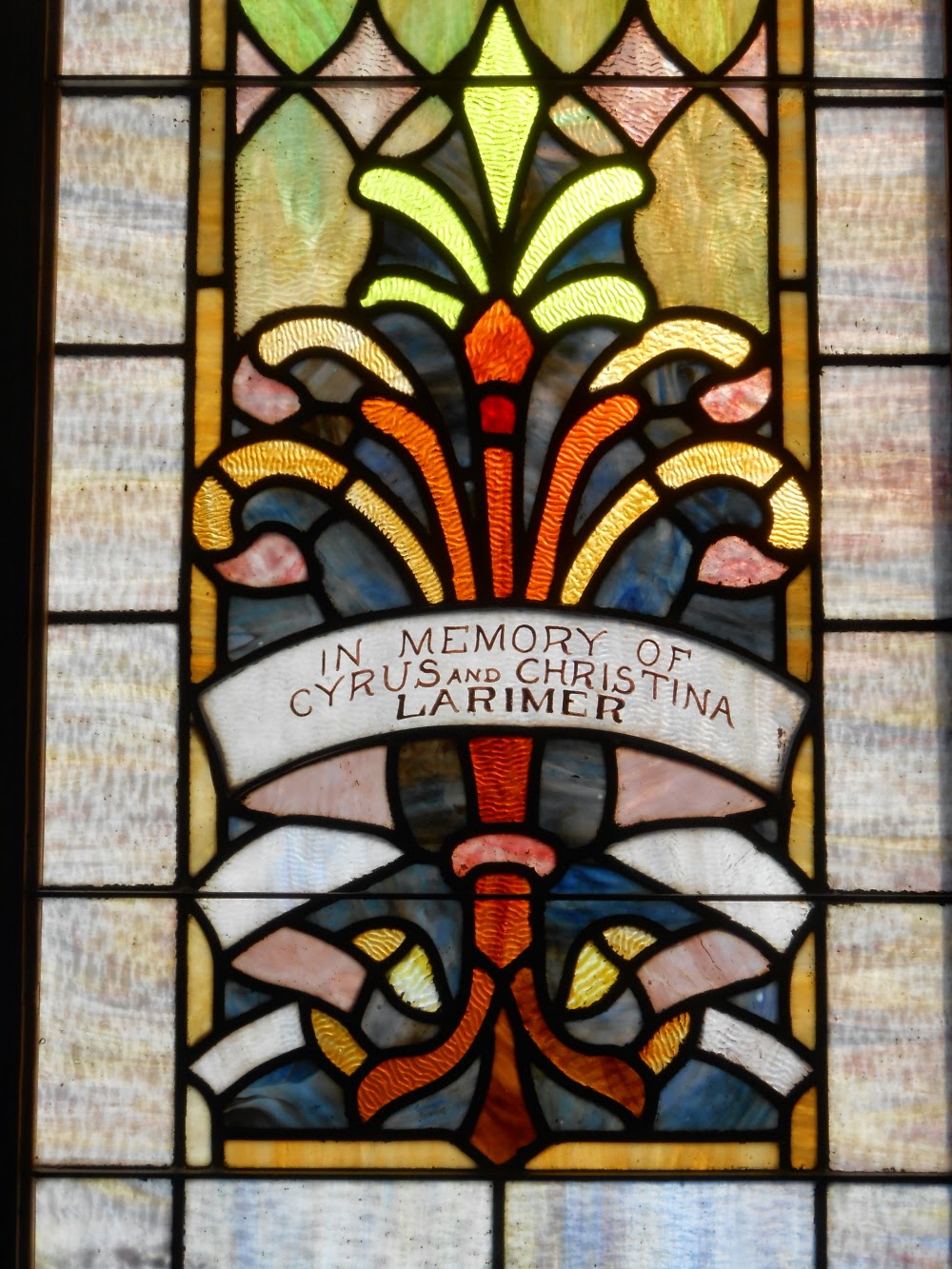Stained glass certainly is among the principal glories of Chariton's First United Methodist Church, especially the two huge gothic-arched windows centered in the south and west walls. By some counts there are 32 windows total (to some degree the total depends upon how you count) in the church, but these massive windows have pride of place.
The windows all seem to have been original equipment, designed and manufactured by the Jacoby-Spies Manufacturing Co. of St. Louis. G.A. Spies, the artist to whom the windows are attributed, had started a small glass shop in St. Louis in 1896, then partnered with H.H. Jacoby to expand. He remained as "artist-manager," however. Spies disappears from business records soon after the turn of the 20th century by which time the firm was known as the Jacoby Art Glass Co. --- a firm that remained in business as Jacoby Stained Glass Studios, Inc., until the 1970.
Both great windows are divided into four panels, each with a story to tell.
The most easterly panel of the south window is dedicated to the memory of 25-year-old William Thomas Black, son of Charles and Amanda Black, who had grown up in the Chariton congregation and is described in church histories as an "honored" member of the Epworth League, a denomination-wide association for young adults founded in 1889. That's the Epworth League symbol at the top of the panel.
Young Black enlisted for service during the Spanish American War in Co. H, Iowa Volunteer Infantry, and was serving as quartermaster sergeant in Jacksonville, Florida, when he died there of a fever on July 19, 1898. He was described as "a noble, upright, Christian young man who always took an active part in church work, but was cut down in the vigor of manhood ...." Members of the Epworth League, as well as others, contributed toward the cost of the window. Black's remains were returned for burial in the Chariton Cemetery.
The second panel commemorates Lucas County's Daniel Iseminger Post, Grand Army of the Republic, part of a nationwide association of Union veterans of the Civil War. The crossed flags at the top were among the organization's symbols. By 1898-1900, most G.A.R. members --- many of them Methodist --- ranged in age from late 50s to 70s, and having survived the war now were doubly conscious of their mortality. Unlike more recent veteran organizations, the G.A.R. ceased to exist upon the death of its last member, so relatively few public reminders of it remain. The Civil War memorial on the courthouse lawn in Chariton also was a project of the G.A.R.
It was not uncommon for turn-of-the-century churches, especially Methodist ones, to include G.A.R. windows. More elaborate G.A.R. windows from demolished Methodist churches in Lineville and Osceola now are housed in county museums; G.A.R. windows in Carlisle and Centerville United Methodist churches remain in place.
The third panel commemorates Chariton's "Traveling Men." This seems to have been an informal association of traveling sales representatives home-based in Chariton --- and according to newspaper reports of the time this was a large group because of the advantages the town offered. It had all the smaller-town amenities men who spent much of their lives on the road could wish for their families plus excellent transportation. It was possible in 1900, for example, to depart (or arrive in) Chariton by rail in four directions --- west to Denver, Omaha and beyond; east to Ottumwa, Burlington and Chicago; northwest to Des Moines; and southwest to St. Joe and Kansas City.
R. Webb Hultz, a Presbyterian who by 1900 had represented the Tones Spice Co. for more than 20 years, seems to have been a leader of the group which engaged in various social activities --- including baseball --- as well as doing good works. The Traveling Men also contributed a window, sold off many years later by a private owner, when the new United Brethren church was built.
The final window commemorates Cyrus Larimer and his wife, Christina (Christiana, according to her tombstone and family records). Cyrus, who enlisted for Civil War service from Chariton in Co. K, 34th Iowa Volunteer Infantry, died of disease at age 34 on Sept. 23, 1864, in Louisiana. Christiana, who arrived in Chariton during 1855 as the widow of William McDowell Larimer and was an early school teacher in the Highland district, married Cyrus as her second husband. She died in 1884.
Christiana had two sons who were prominent businessmen in Chariton as well as Methodists. George W. Larimer, from her first marriage, married Emma Ward and built, among other structures, the widely admired home that still stands at the intersection of East Auburn Avenue and Fifth Street. The other son was Horace. So that family connection no doubt explains the presence of this window at First United Methodist Church.












No comments:
Post a Comment